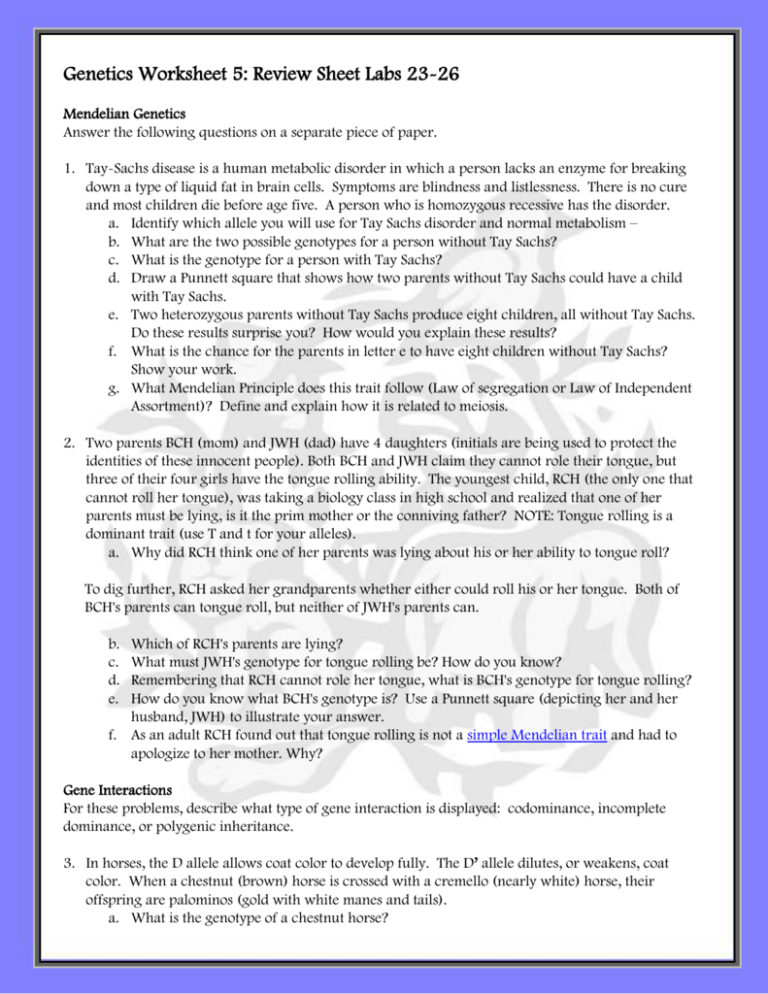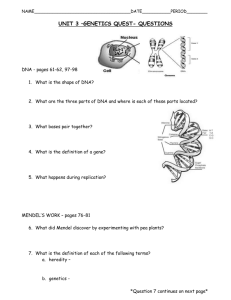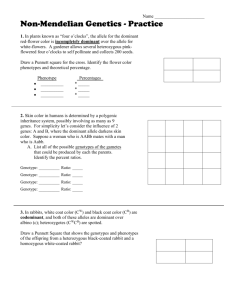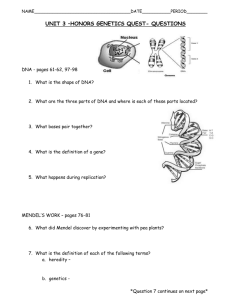Genetics Problems
advertisement

Genetics Worksheet 5: Review Sheet Labs 23-26 Mendelian Genetics Answer the following questions on a separate piece of paper. 1. Tay-Sachs disease is a human metabolic disorder in which a person lacks an enzyme for breaking down a type of liquid fat in brain cells. Symptoms are blindness and listlessness. There is no cure and most children die before age five. A person who is homozygous recessive has the disorder. a. Identify which allele you will use for Tay Sachs disorder and normal metabolism – b. What are the two possible genotypes for a person without Tay Sachs? c. What is the genotype for a person with Tay Sachs? d. Draw a Punnett square that shows how two parents without Tay Sachs could have a child with Tay Sachs. e. Two heterozygous parents without Tay Sachs produce eight children, all without Tay Sachs. Do these results surprise you? How would you explain these results? f. What is the chance for the parents in letter e to have eight children without Tay Sachs? Show your work. g. What Mendelian Principle does this trait follow (Law of segregation or Law of Independent Assortment)? Define and explain how it is related to meiosis. 2. Two parents BCH (mom) and JWH (dad) have 4 daughters (initials are being used to protect the identities of these innocent people). Both BCH and JWH claim they cannot role their tongue, but three of their four girls have the tongue rolling ability. The youngest child, RCH (the only one that cannot roll her tongue), was taking a biology class in high school and realized that one of her parents must be lying, is it the prim mother or the conniving father? NOTE: Tongue rolling is a dominant trait (use T and t for your alleles). a. Why did RCH think one of her parents was lying about his or her ability to tongue roll? To dig further, RCH asked her grandparents whether either could roll his or her tongue. Both of BCH's parents can tongue roll, but neither of JWH's parents can. b. c. d. e. Which of RCH's parents are lying? What must JWH's genotype for tongue rolling be? How do you know? Remembering that RCH cannot role her tongue, what is BCH's genotype for tongue rolling? How do you know what BCH's genotype is? Use a Punnett square (depicting her and her husband, JWH) to illustrate your answer. f. As an adult RCH found out that tongue rolling is not a simple Mendelian trait and had to apologize to her mother. Why? Gene Interactions For these problems, describe what type of gene interaction is displayed: codominance, incomplete dominance, or polygenic inheritance. 3. In horses, the D allele allows coat color to develop fully. The D’ allele dilutes, or weakens, coat color. When a chestnut (brown) horse is crossed with a cremello (nearly white) horse, their offspring are palominos (gold with white manes and tails). a. What is the genotype of a chestnut horse? b. What is the genotype of a cremello horse? c. What is the genotype of a palomino horse? d. Draw a Punnett square to show the results of a cross between palomino horses. 4. Normal hearing depends on the presence of at least one dominant in each of two genes, D and E. Mark's genotype is DdEe and Emily's is DdEe. What chance do they have of having a child who is deaf? A child who is homozygous? 5. Allen is a hearing person with genotype DDEe. His wife, Maria, has the genotype ddEE. a. Is Maria deaf? Explain. b. What are the chances of this couple having a deaf child? c. Is there a possibility that any of their children would be a carrier for deafness? Explain. 6. Erminette chickens have the genotype FBFW and are speckled black and white. Draw a Punnett square to show the genotype and phenotype ratios of a cross between two erminette chickens. 7. In petunias, red color is due to R, white color is due to R’, and the heterozygous condition results in pink. a. Draw a Punnett square to show the genotype and phenotype ratios of a cross between two pink petunias. b. What is the difference between these ratios and the ratios of a cross between two heterozygous individuals that display complete dominance? 8. A farmer has a red-haired bull, HRHR, and a white-haired cow, HWHW. A cross of these two yields a calf with pinkish brown hair known as roan. Upon closer examination, he notices that the calf's coat is a mixture of red hairs and white hairs. Draw a Punnett square to show the genotype and phenotype ratios of a cross between this calf and another roan calf. 9. You know that humans can be any height between 4 feet 10 inches (Maggi O’Neill) and 7 feet 1 inch (Shaquille O’Neal). What type of inheritance codes for human height? Sex-Linkage 10. In fruit flies, red eyes (XR) are dominant over white eyes (Xr). Draw a Punnett square that shows the genotype and phenotype ratios of a cross between a white-eyed male and a heterozygous red-eyed female. 11. Duchenne muscular dystrophy is caused by a recessive allele located on the X chromosome. Draw a Punnett square that shows how two unaffected people can have a child who has Duchenne muscular dystrophy. Show the genotype and phenotype ratios of the offspring. a. Is the child with muscular dystrophy male or female? b. What is the probability that the couple's next child will probably have muscular dystrophy? c. What percentage of the couple's male children will probably have muscular dystrophy? d. What percentage of the couple's female children will probably have muscular dystrophy? 12. Hemophilia is caused by a recessive allele on the X chromosome. Using XH for normal clotting and Xh for non-clotting found in hemophiliacs, draw a Punnett square that shows how a mother whose blood clots normally can have a daughter with hemophilia. a. What is the father's genotype and phenotype? b. Why is it extremely uncommon for a female to have hemophilia? 13. Not all sex-linked genes are recessive. For example, Alport syndrome is caused by a dominant allele on the X chromosome. The disease is characterized by end-stage kidney disease, and hearing loss. The disorder was named after Cecil A. Alport, a University of Edinburgh Medical School graduate who first identified the disorder in a British family in 1927. a. Using A to represent the allele for Alport syndrome, draw a Punnett square that shows the possible offspring of a woman with genotype XAXa and a man with genotype XaY. b. What percentage of the children have Alport syndrome? c. Who is most likely to get the disease, males or females? Explain.








